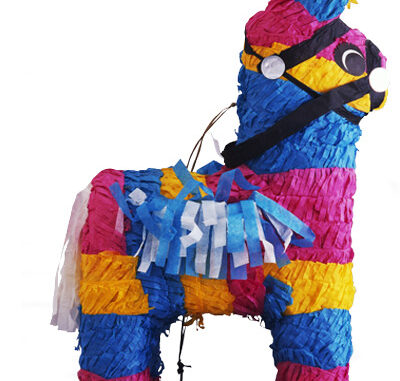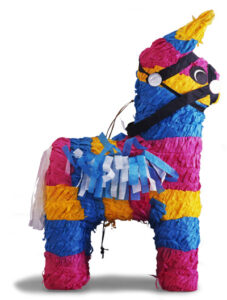

©Lawrence Manning/Corbis
A colorful piñata
The classic piñata is actually a pottery jar that has been filled with fruit, candy, and gifts, and is brightly decorated with ribbon and paper to resemble an animal or a many-pointed star. The piñata is hung in the air at fiestas. Blindfolded party-goers either pull strings that open a hidden flap in the piñata or take turns trying to hit it with a stick. When the piñata breaks, the party-goers are showered with candy and gifts.
Although piñatas are strongly associated with Mexican culture, they most likely originated in China. Marco Polo probably brought the idea of breaking paper-covered animal figures filled with seeds from China to Italy. In Italy, where the word for “fragile pot” is pignatta, people started making these figures for the first Sunday of Lent and filling them with trinkets. The custom spread to Spain, where the Lenten piñata Sunday became a fiesta.
The piñata was brought to the Americas by Spanish missionaries, who used it for religious instruction. Wielding a stick that symbolized virtue, blindfolded participants tried to hit a piñata that symbolized disguised evil. The candies and fruits that rained down from the broken piñata represented the participants’ reward for keeping their faith.
Slowly, the piñata lost its religious association and today it is generally viewed as a symbol of fun. Hispanic families still sing the traditional song while taking turns at the piñata:
Dale, dale, dale, no pierdas el tino, porque si lo pierdes, pierdes el camino. Esta piñata es de muchas mañas, solo contiene naranjas y cañas. (Hit, hit, hit. Don’t lose your aim, because if you lose it, you lose your way. This piñata is full of tricks, it only contains oranges and sugar cane.)